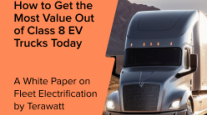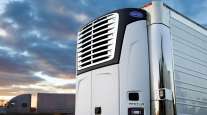Electric Trucks Already in Service in California, but Obstacles to Widespread Use Remain

A transportation veteran of 38 years, Simon’s 5-year-old company, TransPower, has 14 trucks — nine on-road — currently in service, with plans to raise that number to 50, 34 of them on-road by the end of next year.
“Contrary to popular belief, there actually are 80,000-pound Class 8 trucks operating on an everyday basis using an electric-powered battery and producing zero emissions,” Simon said on Jan. 11 at a session of the Transportation Research Board’s annual meeting. “There are customers who feel that there’s a [good] business case for these vehicles.”
A decade ago, Simon was working for a company that produced hybrid trucks whose fuel economy was marginally better than those of conventional diesel-powered vehicles. Transpower’s trucks were five years in the making before they became operational in 2015.
Among the firms using Transpower’s on-road trucks are Cal Cartage, NRT and TTSI with Knight Transportation, Pasha and 3 Rivers Trucking soon to receive theirs. Simon claims the trucks save $378,000 in energy costs during a 300,000-mile working lifetime.
APM Terminals, Ikea, Osterkamp and Pasha are using the yard tractors that Simon says will save $121,500 during a 150,000-mile working lifetime. According to testing done at the University of California-Riverside, Transpower’s trucks reduce energy costs by 85% and greenhouse-gas emissions by 67%.
Transpower’s yard tractors have driven 17,000 miles at IKEA while operating on all three shifts. All told, they’ve traveled 45,000 miles.
Among the challenges preventing true large-scale market penetration are: batteries have improved but still make the trucks 6,000 pounds heavier than diesel models; on-road trucks can only travel 80 to 100 miles fully loaded before they run out of power; and they cost two to three times more than a conventional truck. The eight to 10-year payback in greatly reduced energy costs is longer than most owners’ “investment horizon,” said Simon, who hopes to cut that period in half in the not-too-distant future.
Simon said he believes that Transpower’s adapted Fisker engines combined with Eaton automated manual transmissions go a long way toward solving those problems. Of course, these trucks are still not suitable for longhaul duty. Right now, they represent small niche applications.
“There’s a clear path to zero emissions … [but] I don’t think the tools are in place to make that happen,” said Thomas Jelenic, vice president of planning for Highland Fairview, a large-scale industrial developer in Southern California. “Until industry has clear markers … they will not produce that vehicle. [And] unless people are able to buy hundreds or thousands of trucks, it’s not going to change what we have deployed."
Some of the panelists speaking at the first of the two emissions sessions agreed that there are considerable challenges to achieving zero emissions.
“You have to have a market pull,” said Matt Miyasato of the South Coast Air Quality Management District in Southern California. “But … if we can get the funding in place to push the technology, then we can potentially get to larger orders and then larger volumes.”
The Department of Energy’s Robert Graham regards political challenges as the biggest obstacle.
“I don’t think that from a political perspective there is the will, especially in the statehouses and the federal government, to spend the kind of money that will be necessary to really, truly move the market,” Graham said.
James Jack, executive director of the Sacramento, California-based Coalition for Responsible Transportation, said he is less concerned about political will since his state is a leader in rigorous emissions enforcement.
Money is his concern.
“The incremental cost to move to these technologies can be incredibly expensive,” Jack said.
Dawn Fenton, director of sustainability and public affairs for Volvo Group North America, agreed in part that costs are a challenge, but said more importantly the technology has to make business sense.
“You can basically make those brand-new vehicles almost free through purchase incentives,” Fenton said. “But if the customers don’t want it, they’re not going to buy it. And if the customer doesn’t buy it, the OEM doesn’t make any money and doesn’t stay in business.”




